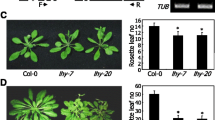Abstract
The circadian clock serves to prepare plants for predictable changes in the environment both on a daily and a seasonal basis. Floral transition in most plants is dependent on day length and, thus, on the season. Sensing day length allows plants to synchronize their reproduction with favorable outside conditions. This process is known as the photoperiodic pathway of flowering time control, and it is tightly linked with the circadian clock of the plant. Thus, mutants with defects in the circadian system can also be impaired in photoperiodic flower induction. This chapter provides a detailed description of the methods used to determine flowering time in the model species Arabidopsis thaliana and Hordeum vulgare and to assign a mutant or a transgenic plant to the photoperiodic pathway of flowering.
Access this chapter
Tax calculation will be finalised at checkout
Purchases are for personal use only
Similar content being viewed by others
References
Srikanth A, Schmid M (2011) Regulation of flowering time: all roads lead to Rome. Cell Mol Life Sci 68:2013–2037
Andres F, Coupland G (2012) The genetic basis of flowering responses to seasonal cues. Nat Rev Genet 13:627–639
Wang J-W, Czech B, Weigel D (2009) miR156-Regulated SPL transcription factors define an endogenous flowering pathway in Arabidopsis thaliana. Cell 138:738–749
Dodd AN, Salathia N, Hall A et al (2005) Plant circadian clocks increase photosynthesis, growth, survival, and competitive advantage. Science 309:630–633
Staiger D (2001) Circadian clocks: CONSTANTS lends its zinc finger. Trends Plant Sci 6:293
Suarez-Lopez P, Wheatley K, Robson F et al (2001) CONSTANS mediates between the circadian clock and the control of flowering in Arabidopsis. Nature 410:1116–1120
Fowler S, Lee K, Onouchi H et al (1999) GIGANTEA: a circadian clock-controlled gene that regulates photoperiodic flowering in Arabidopsis and encodes a protein with several possible membrane-spanning domains. Embo J 18:4679–4688
Sawa M, Nusinow DA, Kay SA et al (2007) FKF1 and GIGANTEA complex formation is required for day-length measurement in Arabidopsis. Science 318:261–265
Fornara F, Panigrahi KC, Gissot L et al (2009) Arabidopsis DOF transcription factors act redundantly to reduce CONSTANS expression and are essential for a photoperiodic flowering response. Dev Cell 17:75–86
Tiwari SB, Shen Y, Chang HC et al (2010) The flowering time regulator CONSTANS is recruited to the FLOWERING LOCUS T promoter via a unique cis-element. New Phytol 187:57–66
Mathieu J, Warthmann N, Kuttner F et al (2007) Export of FT protein from phloem companion cells is sufficient for floral induction in Arabidopsis. Curr Biol 17:1055–1060
Turck F, Fornara F, Coupland G (2008) Regulation and identity of florigen: flowering locus T moves center stage. Annu Rev Plant Biol 59:573–594
Turner A, Beales J, Faure S et al (2005) The pseudo-response regulator ppd-H1 provides adaptation to photoperiod in barley. Science 310:1031–1034
Staiger D, Shin J, Johansson M et al (2013) The circadian clock goes genomic. Genome Biol 14:208
Campoli C, Shtaya M, Davis S et al (2012) Expression conservation within the circadian clock of a monocot: natural variation at barley Ppd-H1 affects circadian expression of flowering time genes, but not clock orthologs. BMC Plant Biol 12:97
Hemming MN, Peacock WJ, Dennis ES et al (2008) Low temperature and day length cues are integrated to regulate FLOWERING LOCUS T in barley. Plant Physiol 147:355–366
Campoli C, Drosse B, Searle I et al (2011) Functional characterisation of HvCO1, the barley (Hordeum vulgare) flowering time ortholog of CONSTANS. Plant J 69(5):868–880
Kikuchi R, Kawahigashi H, Ando T et al (2009) Molecular and functional characterization of PEBP genes in barley reveal the diversification of their roles in flowering. Plant Physiol 149:1341–1353
Lacerenza JA, Parrott DL, Fischer AM (2010) A major grain protein content locus on barley (Hordeum vulgare L.) chromosome 6 influences flowering time and sequential leaf senescence. J Exp Bot 61:3137–3149
Parrott DL, Downs EP, Fischer AM (2012) Control of barley (Hordeum vulgare L.) development and senescence by the interaction between a chromosome six grain protein content locus, day length, and vernalization. J Exp Bot 63:1329–1339
Sasani S, Hemming MN, Oliver SN et al (2009) The influence of vernalization and day length on expression of flowering-time genes in the shoot apex and leaves of barley (Hordeum vulgare). J Exp Bot 60:2169–2178
Greenup A, Peacock WJ, Dennis ES et al (2009) The molecular biology of seasonal flowering-responses in Arabidopsis and the cereals. Ann Bot (Lond) 103:1165–1172
Distelfeld A, Li C, Dubcovsky J (2009) Regulation of flowering in temperate cereals. Curr Opin Plant Biol 12:178–184
Acknowledgement
The co-9 mutant was kindly provided by Prof. Detlef Weigel. Work in the DS laboratory is supported by the DFG (STA653 and SPP1530), and work in the Fischer lab has been supported by the US Barley Genome Project, the Montana Board of Research and Commercialization Technology, and the National Science Foundation.
Author information
Authors and Affiliations
Corresponding author
Editor information
Editors and Affiliations
Rights and permissions
Copyright information
© 2014 Springer Science+Business Media New York
About this protocol
Cite this protocol
Steffen, A., Fischer, A., Staiger, D. (2014). Determination of Photoperiodic Flowering Time Control in Arabidopsis and Barley. In: Staiger, D. (eds) Plant Circadian Networks. Methods in Molecular Biology, vol 1158. Humana Press, New York, NY. https://doi.org/10.1007/978-1-4939-0700-7_19
Download citation
DOI: https://doi.org/10.1007/978-1-4939-0700-7_19
Published:
Publisher Name: Humana Press, New York, NY
Print ISBN: 978-1-4939-0699-4
Online ISBN: 978-1-4939-0700-7
eBook Packages: Springer Protocols




